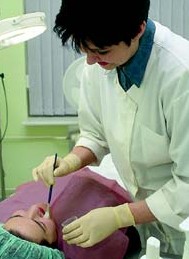|
|
 |
| Dermatology |
 |
 |
 |
|
|
|
An Introduction to Dermatology
|
|
|
The skin is one of the largest
organs in the body. It has a surface area of 1.8 m2 and makes up approximately
16% of our body weight. More importantly, the skin is a
window through which the physician can "see" the entire
body.1.
has a surface area of 1.8 m2 and makes up approximately
16% of our body weight. More importantly, the skin is a
window through which the physician can "see" the entire
body.1.
Dermatology involves but is not limited to study,
research, and diagnosis of normal and disorders, diseases,
cancers, cosmetic and ageing conditions of the skin, fat,
hair, nails and oral and genital membranes, and the
management of these by different investigations and
therapies, including but not limited to
dermatohistopathology, topical and systemic medications,
dermatologic surgery and dermatologic cosmetic surgery,
immunotherapy, phototherapy, laser therapy, radiotherapy
and photodynamic therapy. |
|
|
| The skin is often
referred to as the "integumentary system" composed
of epithelial, mesenchymal, glandular and
neurovascular components. Specifically, the
integumentary system consists of the skin and its
derivatives such as: sweat glands, sebaceous glands,
nails, hair, and arrector pili muscles. Also
included in the system are the mammary glands and
the teeth. |
|
The
skin can also be divided into three main functional
areas:
1) Epidermis: the major protective layer derived
from ectoderm.
2) Dermis: the major support layer derived from
mesoderm.
3) Skin Appendages: cells derived from both ectoderm
and mesoderm:
- Eccrine Sweat Gland
- Apocrine Sweat Gland
- Sebaceous Gland
- Hair Follicle
- Nails |
|
Based
on the thickness of the epidermis, skin can also be
classified as thick or thin:
1) Thick skin covers our palms and soles. It has
sweat glands, but lacks hair follicles, arrector
pili muscles, and sebaceous glands.
2) Thin skin covers most of the rest of the body. It
contains hair follicles, arrector pili muscles,
sweat glands, and sebaceous glands. |
|
|
Functions of the Skin::: |
|
#
barrier to physical agents
# protects against
mechanical injury
# prevents dehydration
of body through fluid loss
# reduces the
penetration of UV Radiation
# helps regulate body
temperature
# provides a surface
for grip
# acts as a sensory
organ
# acts as an outpost
for immune surveillance
# plays a role in
Vitamin D production
# has a cosmetic
association |
|
Arrange to see a dermatologist as soon as possible
when symptoms of skin disease appear, or when current
therapy is ineffective. Expert diagnosis, rapid
cure, or good management means decreased cost and
less suffering.
symptoms of skin disease appear, or when current
therapy is ineffective. Expert diagnosis, rapid
cure, or good management means decreased cost and
less suffering. |
|
| WHAT IS A
DERMATOLOGIST? |
|

Dermatologist
A dermatologist is a physician who is trained to
evaluate and manage pediatric and adult patients
with benign and malignant disorders of the skin,
hair, nails and adjacent mucous membranes. A
dermatologist has had additional training and
experience in the following: |
|
1. The diagnosis and
treatment of skin cancers, melanomas, moles, and
other tumors of the skin.
2. The management of contact dermatitis and other
inflammatory skin disorders.
3. The recognition of the skin manifestations of
systemic and infectious diseases.
4. Dermatopathology.
5. Surgical techniques used in dermatology. |
|
|
Dermatologists also manage cosmetic disorders of the
skin, including hair loss, scars, and the skin
changes associated with aging. |
|
Dermatopathologist: A
dermatopathologist is expert in the microscopic
diagnosis of diseases of the skin, including
infectious, immunologic, degenerative, and
neoplastic diseases. This entails the examination
and interpretation of specially prepared tissue
sections, cellular scrapings, and smears of skin
lesions by means of light microscopy, electron
microscopy, and fluorescence microscopy.
Pediatric Dermatologist:
A pediatric dermatologist is a dermatologist who has
additional training and expertise in the evaluation
and management of skin diseases which occur more
commonly or exclusively in children. Examples
include: all types of birthmarks, neonatal
dermatology, genodermatoses, pediatric infections or
inflammatory processes and skin diseases in children
with complex medical conditions requiring
coordinated multispecialty care.
Dermatologist specializing in Clinical and
Laboratory
Dermatological Immunology:
A dermatologist who utilizes various specialized
laboratory procedures to diagnose disorders
characterized by defective responses of the body's
immune system. An immunodermatologist also may
provide consultation in the management of these
disorders and administer specialized forms of
therapy for these diseases. |
|
|
|
Disclaimer - The
contents of this site are for informational purposes
only. Always seek the advice of a qualified
physician for any doubts. |
| | |


